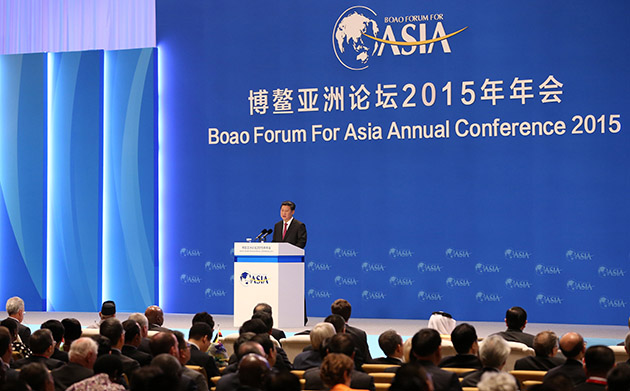Common-destiny community to benefit Asia, world

The Boao Forum for Asia Annual Conference 2015 takes place in Hainan Province on March 28.
Chinese President Xi Jinping’s call for building a community of common destiny has been lauded by academia as beneficial not only to Asia, but to the world as a whole. Xi issued the call during his keynote speech at the Boao Forum for Asia Annual Conference 2015 in Hainan Province on March 28.
Towards a community of common destiny, Xi put forward a four-point proposal appealing to all countries to “respect one another and treat each other as equals; seek win-win cooperation and common development; pursue common, comprehensive, cooperative and sustainable security; and ensure inclusiveness and mutual learning among civilizations.”
“The common-destiny community concept crystallizes theories and practices of China’s new strategy for diplomacy with great powers,” said Pang Zhongying, a professor from the School of International Studies at Renmin University of China.
Pang noted that the community of common destiny has gone beyond the scope of simple interests communities related to trade and investment, encompassing deeper and closer international cooperation in the spheres of politics, security and society.
After the Report of the 18th Communist Party of China National Congress proposed “raising awareness about human beings sharing a community of common destiny,” Chinese leaders have conceptualized the common-destiny community on different occasions.
In 2013, China held an unprecedented work conference on diplomacy with neighboring countries, vowing to promote the common-destiny community consciousness to strike roots in neighboring countries.
Pang said that China’s appeal of building a community of common destiny comes at exactly the right time and reflects the country’s deep insights into the situation in Asia and the world at large.
Currently, adjustments to regional and international order have been accelerated, leading to a complicated transition of world order and triggering heated debate on what kind of international order should be established.
In this context, countries around the world have mapped out different blueprints for the future world order. China’s common-destiny community mode, among others, will not only facilitate international relations to take new shape, but also help intensify global governance, Pang said.
There is no doubt that the building of a common-destiny community is confronted with numerous barriers. The vast differences of Asian countries in development, political systems, social culture and religious beliefs have hindered regional integration. Uncertainties, intervention of non-Asian countries and the lingering Cold War mindset also compound the problem.
Nevertheless, from the perspective of Wang Cungang, a professor from the School of Politics and Administration at Tianjin Normal University, the barriers are indicative of the necessity and urgency to build a community of common destiny for Asia.
“Only by quickening up regional integration can Asia take the initiative in international competition and proclaim itself a stable pole on the world strategic map. A divided Asia will do no good to the region per se and to the transitioning international order,” said Wang.
Many scholars believed that the rise of China will give a huge boost to the building of the Asian community of common destiny. Playing the leading role, China will make real efforts to help countries in the region foster the awareness of the common-destiny community, they claimed.
In fact, a series of significant initiatives raised by China to advance common development in Asia have been pushed ahead step by step.
On March 28, the long-awaited action plan on the “One Belt, One Road” initiative, or Silk Road Economic Belt and 21st Century Maritime Silk Road, was unveiled at the forum, which introduces the background, principles, framework, cooperation priorities and mechanisms of the Initiative.
Preparations for the Asian Infrastructure Investment Bank (AIIB) have also made substantial progress since Russia, Brazil and the Netherlands applied to join the AIIB on March 28.
According to Zhou Fangyin, a professor at Guangdong Research Institute for International Strategies, what the Belt and Road initiative will provide is a diversified platform for regional cooperation. It is flexible and will not rigidify cooperative modes and specific rules, which accommodates to the great disparities of Asian countries in various domains, he added.
Furthermore, the AIIB can offer targeted assistance to many Asian countries to upgrade primitive infrastructure and close huge funding gaps in infrastructure construction, Zhou said.
“In the future, the advancement of the ‘One Belt, One Road’ initiative and the AIIB will change the landscape of economic cooperation in Asia to a large extent and balance the development of Asian countries, therefore weaving the destinies of Asian countries closely together,” added Zhou.
Mao Li is a reporter at the Chinese Social Sciences Today.
